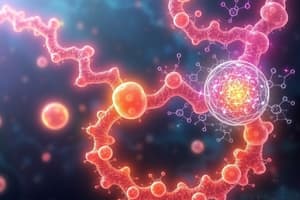Podcast
Questions and Answers
What is the primary product of the cleavage of argininosuccinate?
What is the primary product of the cleavage of argininosuccinate?
- Arginine and malate
- Malate and urea
- Arginine and fumarate (correct)
- Fumarate and oxaloacetate
Urea is filtered by the kidneys and excreted in the urine.
Urea is filtered by the kidneys and excreted in the urine.
True (A)
What substance is formed when fumarate is hydrated?
What substance is formed when fumarate is hydrated?
Malate
In the case of kidney failure, plasma ___ level is elevated.
In the case of kidney failure, plasma ___ level is elevated.
Match the treatment with its intended effect on ammonia production:
Match the treatment with its intended effect on ammonia production:
What compound is produced when bacterial urease acts on urea in the intestine?
What compound is produced when bacterial urease acts on urea in the intestine?
What is the primary route for the elimination of urea from the body?
What is the primary route for the elimination of urea from the body?
What is the primary fate of nitrogen in amino acid catabolism?
What is the primary fate of nitrogen in amino acid catabolism?
Ammonia is safe for the central nervous system and can be freely transported without any modifications.
Ammonia is safe for the central nervous system and can be freely transported without any modifications.
What substance is formed when ammonia is trapped in brain cells?
What substance is formed when ammonia is trapped in brain cells?
The end product of nitrogen metabolism from amino acids is __________.
The end product of nitrogen metabolism from amino acids is __________.
Which enzyme catalyzes the formation of carbamoyl phosphate in the urea cycle?
Which enzyme catalyzes the formation of carbamoyl phosphate in the urea cycle?
The reaction catalyzed by CPS-I is the rate-limiting step in urea formation.
The reaction catalyzed by CPS-I is the rate-limiting step in urea formation.
What happens to glutamine in the liver?
What happens to glutamine in the liver?
Match the following terms with their descriptions:
Match the following terms with their descriptions:
Flashcards are hidden until you start studying
Study Notes
Amino Acid Catabolism
- Amino acid catabolism is the process of breaking down amino acids.
- Nitrogen enters the body through dietary protein.
- Nitrogen leaves the body as urea, ammonia, and other products derived from amino acids.
- The amino acid pool refers to the total amount of free amino acids in the body.
- Protein turnover is the continuous breakdown and synthesis of proteins.
Steps of Amino Acid Catabolism
- Ammonia Formation:
- All amino acids are first transaminated to glutamate.
- Glutamate is then deaminated, forming ammonia.
- Ammonia Trapping:
- Ammonia is highly toxic, especially to the central nervous system.
- Intracellular ammonia is trapped by glutamic acid to form glutamine.
- Glutamine is non-toxic and can be transported to the liver via the bloodstream.
- Final Disposal of Ammonia:
- Glutamine is cleaved by glutaminase in the liver, releasing ammonia and glutamic acid.
- Ammonia is detoxified in the liver by conversion to urea.
- Urea is excreted in the urine.
Urea Cycle
- Formation of Carbamoyl Phosphate:
- One molecule of ammonia condenses with CO2 in the presence of two molecules of ATP to form carbamoyl phosphate.
- This reaction is catalyzed by carbamoyl phosphate synthetase I (CPS-I).
- CPS-I is the rate-limiting step in urea formation.
- Cleavage of Argininosuccinate:
- Argininosuccinate is cleaved to arginine and fumarate by argininosuccinate lyase.
- Fumarate is hydrated to malate, linking the urea cycle to other metabolic pathways.
Fate of Urea
- Urea diffuses from the liver to the kidneys, where it is filtered and excreted in the urine.
- Some urea diffuses from the blood to the intestines, where it is cleaved by bacterial urease to CO2 and NH3.
- This ammonia is partially lost in feces or reabsorbed into the blood.
Clinical Implications
- Kidney Failure: Plasma urea levels are elevated in patients with kidney failure. Ammonia levels also increase due to the action of intestinal bacterial urease.
- Hepatic Encephalopathy: Patients with hepatic encephalopathy may benefit from lactulose, which decreases intestinal ammonia production and absorption.
- Antibiotics: Neomycin can be administered orally to patients with kidney failure to reduce the number of intestinal bacteria and decrease ammonia production.
Studying That Suits You
Use AI to generate personalized quizzes and flashcards to suit your learning preferences.



